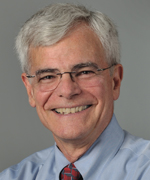From the Deputy Director for Intramural Research
Making Cancer History

Those of you who tuned into the six-hour PBS documentary Cancer: The Emperor of All Maladies—a Ken Burns production based on a Pulitzer prize–winning book by Siddhartha Mukherjee—may have noticed how closely the history of cancer advances parallels the history of the NIH intramural research program. From combination chemotherapy for lymphoma and leukemia, through the discovery of virus vectors and the development of vaccines, to immunotherapy and the promise of personalized medicine, that was us making cancer history.
I was in college and medical school at Harvard in the 1960s when I started hearing about all the amazing work being done at the National Cancer Institute (NCI) and the Clinical Center. Imagine the stark reality back then: Nearly every child with leukemia died of that disease; the survival rate was essentially zero percent.
The pioneering work of NCI’s Emil Frei and Emil Freireich and their four-drug approach placed us on the road to a 90 percent survival rate. The “two Emils”—with the same first name and neighboring labs on the 12th floor of Building 10, but utterly different personalities—were both featured in the Ken Burns documentary, as was NCI Clinical Director C. Gordon Zubrod, who was NCI scientific director during this time. All three ultimately won Lasker awards for their chemotherapy work.
Other NIH heroes—and Lasker winners—of this era include Paul Carbone and Vincent DeVita (combination therapy to treat Hodgkin disease); Roy Hertz and Min Chiu Li (treatment of gestational choriocarcinoma); James F. Holland (use of combination therapy to treat acute leukemia in children); and John L. Ziegler (increasing the cure rate for Burkitt’s tumor by chemotherapy.
If I could insert another episode into Ken Burns’ three-part series, it would include the NIH’s profound contributions to the basic science of cancer. During those heady clinical advances of the 1960s, NCI’s Michael Potter was studying plasmacytomas, antibodies, and the genetic factors leading to the susceptibility and resistance to tumor growth. He would win the Lasker Award in 1984. During the 1970s, NCI’s Robert Gallo was exploring retroviruses and their role in cancer; he’d win the Lasker for that work in 1982 (he also won in 1986 for determining that HIV caused AIDS).
Meanwhile, NCI’s Ira Pastan (who mentored Harold Varmus and Robert Lefkowitz) and Jesse Roth were pioneering the field of receptor biology. In the National Institute of Allergy and Infectious Diseases (NIAID), Anthony Fauci helped spearhead the concerted efforts to understand and control human immunodeficiency virus and its associated immunodeficiencies and cancers.
Decades of research by NCI’s Douglas Lowy and John Schiller paid off with the staggeringly successful vaccine against the human papillomavirus, the leading cause of cervical cancer (and a significant cause of many other cancers, too.) Among their high-profile awards for this achievement was the National Medal of Technology and Innovation in 2014 (http://1.usa.gov/1bvnZRY).
Similarly, Harvey Alter of the Clinical Center co-discovered the hepatitis B virus and laid the groundwork for the detection of the hepatitis C virus, both major causes of liver cancer. Alter won the Lasker in 2000 and the Gairdner award in 2013. In NIAID, Robert Purcell’s work on various strains of hepatitis also led to vaccine development and has reduced the incidence of liver cancer, particularly in China. Although vaccines were mentioned in the cancer documentary only in passing, the work of these NIH scientists will save countless lives. With all these Lasker awardees, it’s no wonder that the Clinical Center itself earned a Lasker, in 2011, for transforming scientific advances into innovative therapies and providing high-quality care to patients.
Palliative care has come a long way, too. Work by NCI’s Lori Wiener and the National Institute of Mental Health’s Maryland Pao on helping teenagers better face an early death was featured in the New York Times on Sunday, March 29, 2015 (http://nyti.ms/1H1Kzxn).
There’s much more to highlight, as you can imagine. I’d like to think my own research on cancer drug resistance has deepened our understanding of cancer…at least in terms of why it is so difficult to cure.
Cancer: The Emperor of All Maladies ended, as expected, on a message of hope, focusing on cancer immunotherapy, named the 2013 scientific breakthrough of the year by the journal Science (http://bit.ly/1QjLc9x). NCI’s Steve Rosenberg, featured heavily in the documentary, is one of the fathers of this field. His, too, has been a decades-long research journey quite possibly on the threshold of profound success.
It was fun to marvel at all of the NIH alumni featured in the Ken Burns documentary: David Nathan, Michael Bishop, Harold Varmus, Rick Klausner, and probably a few more luminaries who trained here in the 1960s and 1970s. But Senator Ben Cardin, in his address to the NIH staff on April 2, aptly noted that the true star of the documentary was NIH itself—that is, you, as members of the vast research enterprise (http://videocast.nih.gov/launch.asp?18925).
As Eric Lander of the Massachusetts Institute of Technology so skillfully summarized in the documentary, advances may seem slow at one level—cancer continues to be a major killer—but considering the complexity of cancer, it is mind-boggling how far the science and treatments have progressed in the last 50 years. I’m not so cynical to think, as some do, that the war on cancer has been lost. The battle rages on, and I dare say we are winning.
To view the PBS documentary Cancer: The Emperor of All Maladies, go to http://video.pbs.org/program/story-cancer-emperor-all-maladies/. To see the list of NIH’s Lasker winners, go to https://irp.nih.gov/about-us/honors/lasker-award.
This page was last updated on Monday, April 25, 2022
